

| Invertebrate news 2021 |
| Insect and Arachnid related news from around Nottinghamshire |
| Want your interesting or notable Nottinghamshire sightings listed? email tpendleton@eakringbirds.com |
|
Chrysolina brunsvicensis back in Nottinghamshire A big surprise to end the year, was the long awaited return of the leaf beetle Chrysolina brunsvicensis (Gravenhorst, 1807) back to VC56 after a 100 year absence. Chrysolina brunsvicensis has always proved historically rare in Nottinghamshire, with records prior to 2021 from Attenborough in 1903 and Barrow Hill Wood in 1908. After much searching personally and checking any Chrysolina hyperici found over recent years, Chrysolina brunsvicensis was suddenly found at Blidworth Woods by David Shaw in October 2021. David then found it at Hangar Hill Plantation and near Budby Pumping Station in November 2021 while I turned it up at Carburton Border and most recently (20/11/21) at two locations in Clipstone Old Quarter. Very similar to the much commoner Chrysolina hyperici (the two species have been found together at at least one Nottinghamshire site) with differences in the puncturation being the best indicator of species, but specimens showing a beautiful claret colouration usually prove to be C. brunsvicensis. It seems to prefer St John's Wort (Hypericum sp) growing along the sides of forest tracks. |
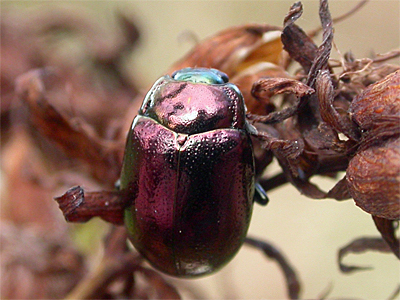 |
|
|
Two new leaf miners for Nottinghamshire
Despite the lateness of the year (October) proposed additions to the county moth list continues, with the discoveries of one moth on it's way north through the UK and a non-native, tropical moth, now found worldwide through the importation of Citrus plants by the horticultural trade. The first of the two moths are Stigmella aceris (Frey, 1857) which was formerly rare nationally and confined to southern counties, but has been increasing it's UK range in recent years. It was discovered new to Nottinghamshire when mines were found on Norway Maple at Retford Cemetery in late September 2021 and follow up records have come quickly, from Bardill's Garden Centre in Nottingham and at a car park near Newark Castle in October 2021. The other new species is Phyllocnistis citrella (Stainton, 1856) which is an adventive species of tropical origin and one which in the UK, is thought to only be found in garden centres on imported Citrus plants. What is believed to be Nottinghamshire's first record, was a mine found on Lemon (Citrus limon) plants for sale at Bardill's Garden Centre again on October 13th 2021. |
| .... |
|
Some recent Flatworm records
from around the county
Terrestrial Flatworms belong to the Phylum Platyhelminthes, which includes a number of aquatic Flatworms and the parasitic Flukes and Tapeworms. They are characteristically smooth and glossy, covered in a slimy mucus and varying in size from a centimetre upwards ..... and we know relatively nothing about them and the threat they pose to native earthworms. |
||
| .... | ||
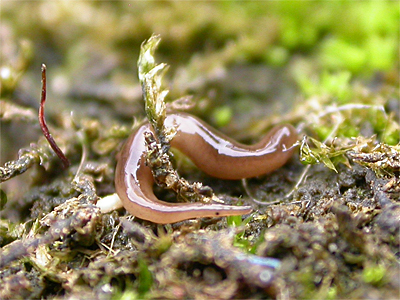 |
To say they are
little studied is something of an understatement, as even
historically, no one in Nottinghamshire has ever looked at them
until recently and we have no historical records to go on either.
Although not your typical invertebrate, they are amazing and
extremely interesting creatures, plus they represent a big threat to
local earthworm populations and yet we still know virtually nothing
of their local distribution. Tim Sexton and myself have done some recording of Flatworms in the past few years and in an effort to try and find out more about the county's species and their range, I recently made a concious effort to look for them and garden centres are the ideal starting point. Most local garden centres have been casually surveyed now and one garden centre just outside Worksop has been the only productive location in terms of records. To date (October 14th 2021) it has produced four species within the same outdoor plant sales area, where the plants are stood directly on layers of polythene membrane. So far, this is the only garden centre to have plant standing without a layer of gravel, or the plants being stood well off the ground, so it makes searching for Flatworms easier. |
|
| .... | ||
|
Of the four
species, the
Obama Flatworm
Obama nungara
(Carbayo, Álvarez-Presas, Jones & Riutort, 2016) from South
America, is thought to be new to Nottinghamshire, while the
Australian Flatworm
Australoplana sanguinea
(Dendy, 1891) and the small
Rhynchodemus sylvaticus
(Leidy, 1851), which is the only Flatworm native to the UK currently
known from Nottinghamshire, have been recorded from he county
before. The arrival of most Flatworms into the UK, have all come as the result of plant importation from around the world, so the potential for more harmful species to turn up is high and another 'problem' species - the Southampton Flatworm Caenoplana variegata (Graff, 1899) has just been found in Nottinghamshire for the first time, when one was recorded at the Nottingham University's Life Sciences building in late September (Thomas Hartman per Tim Sexton). |
||
| .... | ||
|
An Australian import The potential to find and record a range of unlikely species from different parts of the world, always makes garden centres worth visiting and finding such species, is not so unlikely as might be thought. In early October, while heading to Southwell for a walk around the walls of the Minster, I called in at a nearby garden centre and noticed some unusual cribellate webs spun at the top of several Magnolias in one of the cool greenhouses. A spider was located and immediately recognised as being nothing I'd seen before. Suspecting an import, I collected the largest of three spiders I found, took some photographs and posted to Facebook and YouTube as part of a video relating to the find. Thanks to both forms of social media, it was subsequently identified as being Badumna longinqua (L. Koch, 1867) of the family Desidae and a species of Australian origin which has been accidentally imported to several countries in South America, South Africa, Japan, the USA and Europe (Germany). There are UK records, but it is not known how many at the present time. |
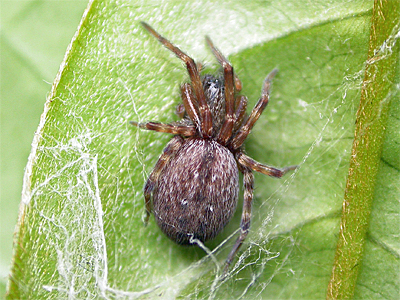 |
|
|
Finally ..... an end to Budby's unidentified Assassin Bug saga - now
confirmed as Coranus aethiops On the Invertebrate News 2020 page, the story of a Coranus type Assassin Bug found on Budby South Forest in 2017 and the need for a male specimen was published. The potential importance of the find was (as is often the case) not realised until viewing the resulting photographs of a female Coranus, with what seemed to have an obviously black underside. |
||
| ..... | ||
 |
So to bring the story
up to date, it is probably best to give those not
aware of this story, more of an insight into this long-running saga, by first repeating what was
originally published on this website in 2020. Back in late July 2017 Dilys and I swept an adult Assassin Bug (Coranus sp) from an area of Budby South Forest. The habitat was grazed lowland heath, containing a mix of Birch and Pine scrub, areas of Bracken and Heather of various ages and condition. We took a number of photographs of the specimen at the time, thinking we were sure of it's identity. Previously, only Coranus subapterus (De Geer, 1773) and Coranus woodroffei (Putshkov, P.V., 1982) had ever been known from the UK, but on return home and after uploading the photographs to our PC's, we noticed that the underside of our specimen was very dark. The angle of our photographs were not the best, but several photographs did show the dark underside quite conclusively and after some research on the internet, we suspected that ours could be Coranus aethiops (Foster 2013).Problem was, we thought that C. aethiops was unknown from the UK, which indeed it was until Stuart Foster re-examined a series of Coranus subapterus specimens collected from Thorne and Hatfield Moors (VC63) in 1979 and 1990. Stuart found that all the specimens were actually Coranus aethiops, making it new to the UK. This boreo-alpine Assassin Bug is a more cold tolerant species and must be regarded as a post-glacial relict species in Britain that has long been overlooked. It can be distinguished from both C. subapterus and C. woodroffei by its black or almost completely black abdominal venter, as well as differences in the shape of the male parameres. We posted images of our specimen on a Facebook group and comments suggested that underside colouration wasn’t a reliable feature. Someone also doubted that C. aethiops would even be on Budby, as it was not suitable habitat. |
|
| ..... | ||
|
But then in early 2019, we were contacted by Keith Alexander, who had heard about our finding of a 'black-bellied' Coranus on Budby and had seen the photographs we had published. Keith told us that two possible C. aethiops had been found on Budby by Keith Fowler (presumably sometime in 2018) and asked if we had taken a voucher specimen. By now we wish we had, but our specimen was female and the extreme difficulty of their identification meant that a female specimen would probably have been of little use anyway. A male was needed. |
||
| ..... | ||
|
Keith also stated in his email, that "a key identification feature is indeed the colour of the underside of the abdomen and this was not visible in our published images. Keith Fowler's Budby specimen also had a black underside and so must be C. aethiops. I have a specimen from a site in Cornwall which also has a black underside. But our specimens are all females and we need to examine a male to be 100% sure of its identity. There appear to be two black-bellied Coranus recognised in Europe at present, with C. niger being full-winged and C. aethiops short-winged, but wingedness tends to vary somewhat in some species, so perhaps should not be relied upon. The black belly does seem to be more reliable". It should be noted that back in July 2012, Dilys and myself found a Coranus sp nymph in a small area of heathland within the neighbouring Sherwood Forest CP. It's identity remained unknown and at the time was presumed to be Coranus subapterus, commonly known as the Heath Assassin Bug and what we thought was the most likely Coranus to be found at Sherwood. So the search for a male specimen continues. Anyone sweep-netting on Budby South Forest should be alert to the possibility of Coranus aethiops being present and any male specimens should be retained, so the identity of the Budby Coranus can finally be sorted out. |
|
|
| ..... | ||
|
This brings us nicely to the present (September 2021) and the latest developments to this story. After Dilys and myself conducted occasional surveys to secure a male specimen, or indeed just to find another specimen at all over the intervening nine years, a concerted effort was made in August 2021 to have yet another go. I visited Budby on August 28th, which was to be the first of four attempts over consecutive dates. A variety of methods were utilised to try and find this elusive species and day one consisted of mostly beating scrub and Heather in the ungrazed roadside strip and the eastern side of Budby South Forest in general. I did try the site of the 2012 female, but after a number of fruitless hours, had nothing to show for the effort. Day two saw more beating of scrub and Heather in the eastern part of Budby South Forest, plus lifting up and grubbing underneath stands of Heather which allowed being lifted easily. Low branches of Pines were also sampled with the beating tray, but there remained no sign of Coranus and silly doubts that it was even there started to creep in by the end of the visit. So on day three (August 30th) I decided to concentrate on grubbing around (hand searching on hands and knees) in any pockets of leaf litter and under Heather and grasses towards the centre of Budby South Forest. This again drew a complete blank and so perhaps it was time for a rethink of strategy. August 31st and day four of the search. If you have ever lost anything, then the first place to look is usually where you last saw it, so I thought it best to return to the location of the 2012 female and try searching there again. I'd already done some grubbing in Pine litter there, but thought I'd ttry slightly further in from the path. There was some small patches of Heather growing in slightly shorter grass and it was here that a large bug moved as I shuffled a small amount of leaf litter just against the Heather. I'd found it after a near ten year wait and it was a male as well. Once potted, the black underside was easily seen and it took ages before it settled and allowed a few photographs. Once safely home, I contacted Keith Alexander to tell him the news and the specimen was sent to him for examination. Keith keyed the specimen out and it did indeed key out to C. aethiops, but because of the difficulty with Coranus identification, Keith sent the specimen to someone with more experience for a final decision as to its identity and Stuart Foster was able to confirm that it was indeed Coranus aethiops. It's an important record nationally, meaning Sherwood Forest becomes only the second confirmed UK site for the species and somewhat changing the criteria of C. aethiops being confined to boreal relic sites like Thorne Moors. So in the end and almost a decade later, this identification mystery has finally been sorted. It took a while, but it was worth it in the end. |
||
|
Yet more new moths for Nottinghamshire The amazing run of new moths to the county continues and as a result, the Notinghamshire moth list available on this website, has already been updated six times this year. It now looks like another is required! Cydia amplana (Hübner, [1799]) - was recorded new to Nottinghamshire, when trapped by Martin Gray in his Broadholme garden on September 5th. Martin's garden is situated directly on the Nottinghamshire border with Lincolnshire in early September 2021, although it is safely in VC56. Formerly suspected of being a migrant, Cydia amplana is thought to have become well established in some southern UK counties, which may have been the origin of a pronounced movement, or dispersal of moths in early September 2021 and which obviously included the Broadholme moth. However, conditions were good at the time for the moths to have been of nearby continental origin, which seems the most likely source. |
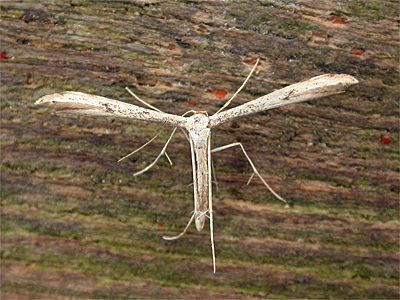 |
|
| ... | ||
|
Mugwort Plume Hellinsia lienigianus
(Zeller, 1852) - A single was attracted to light in Paul
Coombes's Elkesley garden on September 3rd. This moth caused some
differing of opinion when its photograph was posted on Twitter and Plain
Plume Hellinsia tephradactyla was suggested. Plain Plume is
much rarer than Mugwort Plume, for which there are scattered records as
far north as Yorkshire and to make sure of the ID, the moth was sent to
Martin Gray (the Lincolnshire micro moth recorder) for determination. Caloptilia cuculipennella (Hübner, 1796) - A large Caloptilia attracted to MV light at Market Warsop on September 5th, was initially thought to be Gracillaria syringella at first, but looked somewhat different and too 'elongate' to be that species. So after being potted up and looked at closer, suspicions grew to it possibly being Caloptilia cuculipennella. Determination again came from Martin Gray. |
||
|
A Nottinghamshire record of
Grapholita lobarzewskii The remarkable year for moths in the county continues, with what looks set to be Nottinghamshire's first record of the rare Tortrix Grapholita lobarzewskii (Nowicki, 1860) from Mansfield earlier in the Summer. The moth was recorded at light from Graham Beeley's garden back in June 2021 and looks to be the first (and currently only) record for Nottinghamshire. This is another moth which looks set to become more frequent in the county, especially around orchards and gardens containing fruit trees. Grapholita lobarzewskii has been gradually appearing further north for a number of years and recording efforts have no doubt been helped by the availability of a pheremone lure from Anglian Lepidopterist Supplies. |
|
Some recent Ladybird records from south Nottinghamshire Some excellent fieldwork by Seane Browne and Nigel Slater in the south of the county recently, has resulted in a number of records of those 'little black jobs' - namely Ladybirds of the genus Nephus, Rhyzobius, Stethorus and Scymnus. |
||
| ..... | ||
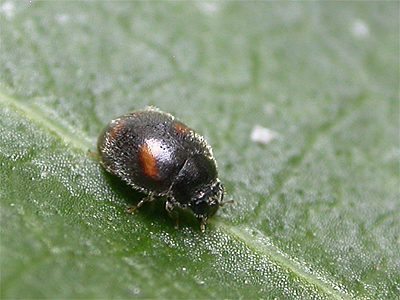 |
These tiny Ladybirds are best looked for by
beating the branches and foliage of everygreen shrubs such as Ivy
and some conifers such as Lawson's Cypress over a tray, so those
invertebrates dislodged, fall onto the tray or sheet and can then be
examined and identified. Several sites have produced records, including Sean's own garden in Chilwell, where he recorded three Nephus quadrimaculatus (Herbst, 1783) and a single Rhyzobius chrysomeloides (Herbst, 1782) from Ivy on 11/08/21. Encouraged by this, Sean contacted Nigel and they beat a mature Chamaecyparis leylandii hedge on Meadow Lane, Attenborough, where they recorded some six Nephus quadrimaculatus, eight Rhyzobius chrysomeloides and two Rhyzobius lophanthae. Nigel had already recorded Rhyzobius lophanthae from Ruddington CP earlier in the month on 03/08/21, which looks to be the second county record, following one at Lambley Cemetery in early 2019.They returned to Meadow Lane on 14/08/21, this time almost immediately recording Rhyzobius forestieri (Mulsant, 1853) new to Nottinghamshire, after being told to look out for it the previous evening. Nigel found Stethorus pusillus (Herbst, 1797) here, which also looks to be new to Nottinghamshire. |
|
| ..... | ||
|
Sean went on to record another Rhyzobius
forestieri from along Meadow Lane again on 16/08/21 and also
recorded 21 Nephus quadrimaculatus and 43 Rhyzobius
chrysomeloides. On 13/08/21 he visited Budby South Forest, where three Scymnus nigrinus (Kugelann, 1794) and a single Scymnus suturalis (Thunberg, 1795) were beaten from scrub Pines. Scymnus nigrinus had been recorded just days before at Oak Tree Heath, during an invertebrate survey of the site, with these records coming long after Nottinghamshire's previous records dating back to 1816 and 1828. |
||
|
Marsh Oblique-barred new to Nottinghamshire Never let it be said that garden trapping is a waste of time and effort. A period of hot, humid weather in mid July produced a run of new species and rare/scarce Nottinghamshire moths to a small terraced garden in the middle of Market Warsop. The run of new species for the garden, saw the garden moth list finally reach 500 species and contributing to that total were (in order of appearance) Abrostola triplasia Dark Spectacle on July 16th, Pyrrhia umbra Bordered Sallow on July 17th, Aethes rubigana and Callimorpha dominula Scarlet Tiger on July 18th, Philereme vetulata Brown Scallop and Epione repandaria Bordered Beauty on July 19th and Monopis crocicapitella and Hypenodes humidalis Marsh Oblique-barred on July 21st, with Marsh Oblique-barred being confirmed by the county recorder as new to Nottinghamshire. I didn't run the trap on July 20th and on each night, the trap was only run from between two and three hours. Rarely is it run for much longer. |
||
|
Rare moth news With the mothing season finally hotting up, there's been a number of interesting county records in July. Phil Lee's Four-dotted Footman is probably the best, but there's also been records of Brown-tail. Four-dotted Footman Cybosia mesomella (Linaeus, 1758) is officially regarded as a major rarity in Nottinghamshire, with Phil Lee's Misterton record of 14/07/21 being the first this century and yet it is frequent over the border in Lincolnshire. Martin Gray (who's Broadholme garden lies on the Nottinghamshire/Lincolnshire border) has recorded this moth on no less than ten occasions since 2004, so it should be expected to occur more frequently than it does, especially at those sites in the east of the county. Brown-tail Euproctis chrysorrhoea (Linnaeus, 1758) is generally a coastal species and only occur sporadically in Nottinghamshire. There had been no county records for over 40 years, before three single moths were recorded at Clumber Park (Gill, N. and Biddulph, T.) and West Bridgford (Hurst, A.) on 07/07/17, then at Ravenshead on 18/07/17 (McGeever, D.). There were no further records until singles at East Bridgeford on 09/07/21 (Reece, J. and Reece, L.) then two on 16/07/21 at Carlton in Nottingham (Adcock, A.) and at Boundary Plantation near Budby (Morton, D. and Ashley, A.) and two at Beeston (Sexton, T.) on 18/07/21. |
||
|
Some recent
Nottinghamshire
sightings This rather strange year continues to turn up a number of surprising records, so thanks to those people who have took the time out to report them. |
||
| ... | ||
|
Tachina grossa
(Linnaeus, 1758) - Vexation Lane on July 13th.
Tachina grossa is a very large Tachinid fly with a
widepread UK distribution. However that distribution does not appear
to cover Nottinghamshire and quite a few other Midland and
south-east counties of the UK also seem to have not recorded this
species. There are no VC56 records listed on the NBN Atas and the
only other county record appears to be one found and photographed by
Peter Smith at Netherfield Lagoons in 2016. Yarrow Pug Eupithecia millefoliata (Rössler, 1866) - To MV light at Mansfield on July 8th and Nottingham on July 9th. Two records within a matter of days, confirm that Yarrow Pug is indeed breeding in Nottinghamshire and should be looked out for. First found in the UK back in the 1930's, this fairly distinctive Pug has steadily increased it's range and first appeared in Nottinghamshire back in 2008, when recorded by Martin Gray at Broadholme on July 26th 2008. Martin recorded a second example on August 1st 2013 and it has most recently been recorded by Nigel Beasley in his Mansfield garden on July 23rd 2020 and again on July 7th 2021. It was then recorded from Andy Adcock's garden at Carlton, Nottingham, on July 9th. |
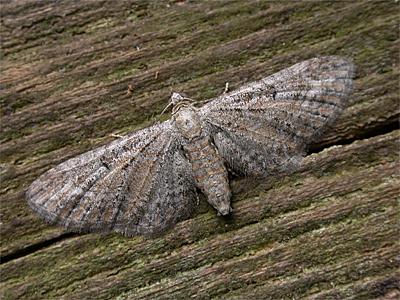 |
|
| ... | ||
|
Muslin Footman Nudaria
mundana (Linnaeus, 1761) - To MV light at Market
Warsop on July 12th. Muslin Footman is very much rare and restricted in
both its
Nottinghamshire range and occurrences, with the last county record coming
Misterton in 2013 (Phil Lee) and from the
Theives Wood/Ravenshead area. The NBN Atlas lists a
series of records from a single Ravenshead locality for
consecutive years between 1994 and 1997 (per Butterfly Conservation),
but the only record with any reliabilty, is the one trapped at Thieves Wood in July
2009 by Sheila Wright and
John Osbourne. Issus coleoptratus (Fabricius, 1781) - Wallingwells Wood July 1st. A number of both adults and nymphs were beaten off Ivy growing on and within a number of deciduous trees and shrubs along the south-facing edge of the wood. According to the NBN Atlas, Issus coleoptratus has a widespread distribution which covers much of the UK's southern counties, although it's distribution does seem rather patchy. Found on many deciduous trees, the Winter is passed in the nymph stage and it was in this stage that Tim Sexton found a nymph at Attenborough NR in January 2018, which is believed to be the first record for Nottinghamshire. |
||
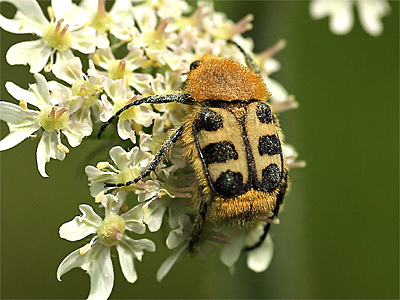 |
The Chafer Trichius gallicus in Nottinghamshire It's not often the contents of an email leave you speechless, but when Sean Browne sent photographs of this stunning French Flower Chafer Trichius gallicus (Dejean, 1821) I had to look twice to make sure that Sean wasn't currently holidaying in France! And when I forwarded Sean's email to Adrian Dutton, the Nottinghamshire county recorder for coleoptera, I think he must have thought along similar lines. But no, Sean had found and photographed it in sunny (continental like) Nottinghamshire. Representing a remarkable and most unexpected addition to the Nottinghamshire fauna, this stunning species is known only from a few localities in southern counties of the UK and slightly closer to Nottinghamshire in Norfolk. Trichius gallicus is a largely continental species, but appears to be moving north. It is believed to have possibly colonised some UK sites in the last few years, so further records could be likely. |
|
|
Bilberry Pug
Pasiphila debiliata
(Hübner, [1817]) found new to Nottinghamshire An unexpected addition to the county fauna, when four unidentified larvae were collected from Bilberry Vaccinium myrtillus, growing at Thieves Wood near Mansfield. Initially suspected as being the larvae of an unknown Tortrix sp, they were taken home to rear through to adult, hoping that they may turn out to be something scarce, or even new to Nottinghamshire. The first moth emerged late evening on June 6th and was identified as Bilberry Pug. This was followed by the emergence of a further two adults the following evening and the three adults (along with an unhatched pupa) were released back at the point of collection the next day. Bilberry is a scarce plant in Nottinghamshire, always meaning that this moth will have a restricted range, if indeed it is found at any other site. |
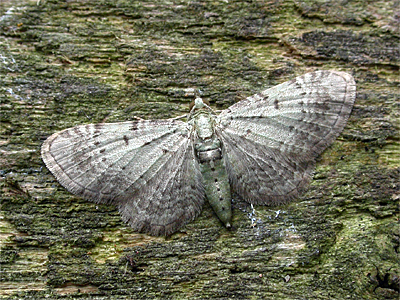 |
|
|
The Tortrix Pammene suspectana
(Lienig & Zeller, 1846) found in Nottinghamshire Samantha Batty recorded three examples of Pammene suspectana to the FUN pheremone lure at Treswell Wood on May 27th 2021. And although the identity has still to be confirmed by examination of the genitalia and the county status officially determined by the county recorder, it looks to be the first Nottinghamshire record. Pammene suspectana was until recently known only from East Anglia, but with the availability of two (FUN and SUS) pheremone lures available from Anglian Lepidopterist Supplies, it has been recorded more widely recently and has since been found to be present at a number of Lincolnshire sites, plus one in Nottinghamshire by Martin Gray. I have tried both Treswell and Kirton Woods during the early afternoon and Wellow Park in the evening with the SUS lure, but have so far failed to record it. |
||
|
A new site for Broad-bordered Bee Hawk-moth
in Nottinghamshire and a first for Sherwood Forest Broad-bordered Bee Hawk-moth Hemaris fuciformis (Linnaeus, 1758) is not only one of our most spectacular day-flying moths, but a big rarity in Nottinghamshire. It's a moth few have seen in VC56 and any sighting comes more by chance than anything else, but it appears to be on the increase. |
||
| .... | ||
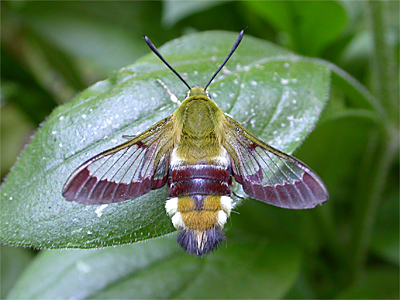 |
It's a moth few have seen in
VC56 and any sighting comes more by chance than anything else, but
it appears to be on the increase. Historically, this spectacular moth has never been common in Nottinghamshire and it remains absent from several woodland sites which do seem suitable. For many years and following a number of records, Clumber Park remained the only site where breeding was known to occur, but singles have occasionally been reported from elsewhere. The moth is certainly present in the Rufford/Centre Parcs area and has recently (2021) been found and confirmed as having bred for the first time in the Sherwood Forest, with both adults and eggs found in 2021. Other recent county records have come from Centre Parcs in 2018 (Hill, M.), Barnby-in-the-Willows (Beacock, O) and Thoresby Park in May 2020 (Kiemel Green, I.) and Clipstone Old Quarter and Blackpool Plantation in Sherwood Forest (Pendleton, T.A.) which represent new sites for the moth in Nottinghamshire. |
|
|
Micropetrix aureatella (Scopoli, 1763) Micropterigidae recorded
from Thieves Wood A single specimen of this attractive moth, was photographed and recorded on Bilberry (Vaccinium myrtillus) growing at Thieves Wood on May 24th 2021. The find was completely accidental (as are so many) and it is believed to be the first county record for many years, but am waiting on word from the county recorder. Bilberry is thought to be the larval foodplant and in Nottinghamshire is something of a rarity itself, being largely restricted to Thieves Wood and a small area of Sherwood Forest CP. |
| Small Eggar again present at Sutton-on-Trent | ||
| ..... | ||
| One of
Nottinghamshire's rarest moths, the Small Eggar Eriogaster
lanestris
(Linnaeus,
1758) had a very good year in 2020,
with reports of at least one larval web from the county's regular
Sutton-on-Trent site. But there were also reports of larvae being
found from other counties close to Nottinghamshire, where its even
rarer. The Small Eggar's rarity of isn't helped by it's choice of habitat in VC56 and it is prone to annual or biennial flailing of roadside hedgerows while in the pupal stage and late cutting in the early months of the year. With adults on the wing from late February into March, this is a moth which has probably not been seen as an adult in the county for many decades, during which time it has always been (quite correctly) labelled as 'hanging on' here and was even thought to have become extinct, until larval webs were found again in 2020. So I went out there on May 26th 2021 and walked along the Sutton-on-Trent lane it seems to have favoured in since 2000, eventually finding a larval web containing a number of larvae. |
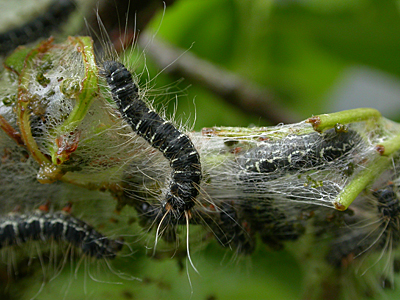 |
|
| ..... | ||
| All of the county's recent Small Eggar records have been from the Sutton-on-Trent, Besthorpe and Collingham area north of Newark, where larval webs were recorded for the first time in over 60 years in 2002, 2003, 2004, again in 2007 and most recently in 2020. | ||
|
Wider surveying increases the Nottinghamshire range of Platybunus pinetorum
What seems to be unique surveying work (at least here in the UK) to help determine the range and status of Platybunus pinetorum in Nottinghamshire, has provided some truly remarkable results. On May 7th, it was found to have a much wider range locally to Gleadthorpe, where the county's first record came from in 2020, which is showed in the image below. |
||
| ... | ||
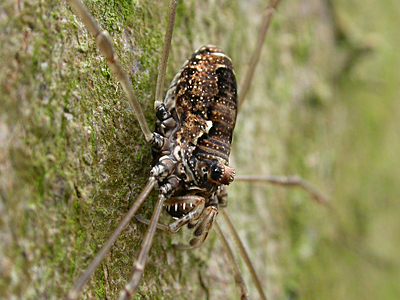 |
That was pleasing enough, but it has now been found at several
woodland sites along the A614 and A57 at Clumber Park and Appleyhead
Wood, further south down the A614 near Ollerton and on the A6075
Peafield Lane near Market Warsop. Rather disappointingly, no one
else seems to have the interest to research the local range of
pinetorum in other UK counties and it seems that there are few (if
any) other records from a woodland or rural location. All sites are largely Beech woodland, or at least have a decent proportion of Beech. There seems to be evidence building now to suggest that pinetorum prefers lightly shaded woodland, with little understorey vegetation. Several sites do have a limited ground flora such as Bluebell and Bramble. One of the Clumber sites produced a count of 104 individuals before counting stopped. Out of 150 Platybunus pinetorum recorded this year to date, all but one have been located on the trunks of smooth barked trees and situated from between one and eight feet above ground level. Several trees have produced counts of five individuals and certainly three to a tree is nothing unusual at well populated sites. All those found have been well distanced from each other, usually well over a foot apart. Only once have I seen two individuals within touching distance and they certainly don't group in the way most Leiobunum often do. |
|
| ... | ||
| Beech is very much the preferred tree of choice with 96% of all records coming from Beech, followed by Sycamore 2%, Sweet Chestnut, Pine and fencing and postsetc 0.6%. Early studies of the data also shows there is evidence suggesting our road and possibly rail infrastructure might be an important factor in its distribution, as all but three sites are close to roads and laybys in particular. Survey work is continuing. | ||
| Hopes
for an exciting Autumn of migrant lepidoptera
As Spring seems to have finally arrived as we get further into May, there is the very good chance that moth trappers could well be adding an exciting new moth to the Nottinghamshire species list. There was a major passage of Striped Hawk-moth Hyles livicorna into Spain during the second week of April and a number of individuals have already been trapped in various locations across the UK. It will certainly be the moth we all hope to get in Nottinghamshire this Summer and Autumn. Decent numbers of Gem Nycterosea obstipata, also arrived into the UK, along with common migrant moths such as Dark Sword-grass Agrotis ipsilon, Silver Y Autographa gamma and Diamond-back Moth Plutella xylostella. But its not just moths that have arrived, with reports of good numbers of Painted Ladies at some southern sites in the second week of May. All in all, it could be a good year. Informaion via the Migrant Lepidoptera (GB & Ireland) group on Facebook. |
|
More records of Platybunus pinetorum Fieldwork in late March and into May 2021, has not only confirmed that the Harvestman found new to VC56 Nottinghamshire at Gleadthorpe last year was not just a one off record, but that it is more expansive away from the location of the original find. Platybunus pinetorum (C.L. Koch, 1839) is a very attractively marked Harvestman and until late last year, was thought to only occur in the UK as females. So far in 2021, it is still only females which have been found in the area local to the original 2020 record. By May 7th, most specimens recorded have been adult, or appear to be about to go through their final moult. All have been found by searching the smooth trunks of Beech and Sycamore and all have been found resting between two and seven feet off the ground. In fact, survey work has shown some Platybunus pinetorum show great loyalty to their chosen tree and one female has been recorded on the same Beech between March 31st and May 5th also being recorded on April 17th between these dates and moulting to adult during that time. To date (May 8th) a total of 14 different individuals have been recorded and over an unexpectedly wider area than was originally anticipated. This total includes five individuals on the same Sycamore trunk on May 5th, but all five appeared to have gone a day or so later, or at least had retreated to more sheltered locations in the leaf litter during cooler weather. But as with any habitat in the Dukeries/Sherwood Forest area, there's always a downside and the downside in this instance, is the felling of all the Beech woodland in the area. Potentially its a disaster for this new Nottinghamshire resident. The problem is, should any specimens be moved to a new site elsewhere, or do nothing? |
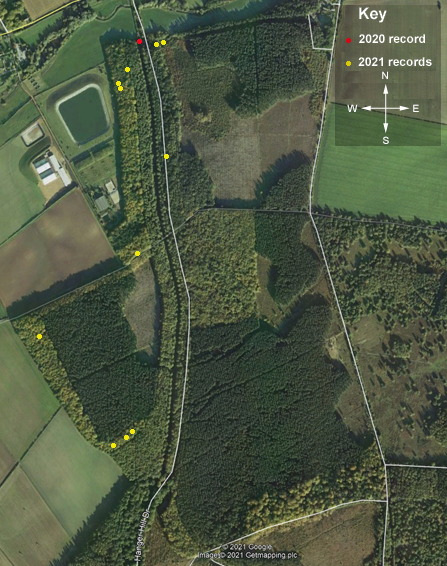 |
|
| Some
recent Nottinghamshire coleoptera records
As Spring continues (albeit at a very slow pace this year) there have already being some notable county records produced. Thanks to the county coleoptera recorder Adrian Dutton, for supplying his more interesting records of 2021 so far. Bembidion doris (Panzer, 1796) A rare Nottinghamshire ground beetle (Carabidae) of marshy sites, but especially close to water. Six were found under a log situated in partly submerged grass, at the edge of a shallow lagoon at Warsop Wood in late April 2021. Platyderus depressus (Audinet-Serville, 1821) A ground beetle with a predominantly south-eastern UK distribution, there are few Nottinghamshire (VC56) records, including one found under a old tree stump in grass pasture at Gunthorpe in April 2021. The only other county records are from Gunthorpe in 2004 (Dutton, A.) and Worksop Priory in 2015 (Pendleton, T.A. and Pendleton, D.T.). Cryptolestes duplicatus (Waltl, 1839) A small beetle found under the bark of deciduous trees. Only recorded for the first time in Nottinghamshire in March 2020 from Sherwood Forest CP (Pendleton, T.A.) and recently found there again on April 25th 2021 (Dutton, A.). Neocoenorrhinus germanicus (Herbst, 1797) Three specimens of this attractive blue Weevil found on Bramble at Cockglode Wood (Pendleton, T.A.) on April 24th. The only previous Nottinghamshire record appears to be from Barton-in-Fabis on August 31st 2011 (Wright, R.J.). Omphalapion hookerorum (Kirby, W., 1808) A Weevil with few county records. A specimen was swept from Hoveringham on April 20th (Dutton, A.). |
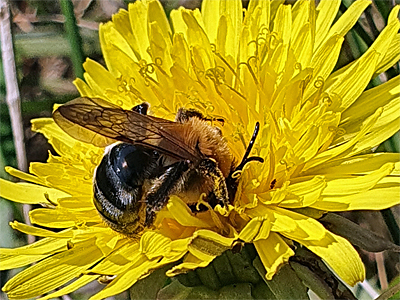 |
Increasing or overlooked? This strange Spring of pleasant warm sunny days, but cold enough to induce an overnight frost, has been good for a superb show of tree and shrub flower and has produced one of the best shows of Blackthorn Prunus spinosa blossom of the past 50 years. It's been remarkable. And with all the flowering, Spring 2021 seems to have been a good year for many Bees. Bombus terrestris appears to have done well with Queens in good numbers at sites visited and I've already (April 10th) recorded Bombus hypnorum workers, which seems a very early date for Nottinghamshire. But many solitary species are also doing well so far in 2021 and there have been a number of records of Andrena nitida (Müller, 1776) often called the Grey-patched Mining Bee sent in. Our former Colliery spoil heaps seem to be favoured, with records from Thoresby Pit Top (David Shaw) and Gedling Pit Top, but it has also been found a Woodthorpe Park in Nottingham (Duncan Lyon). |
|
| Nottinghamshire's first record seems to have been from Clumber Park in 2008 (Phillips, A.L.) and so it is likely that the recent increase in records is as much down to increased interest in Hymenoptera over the past few years, rather than any sudden increase on the bee's part. Unusually for an Andrena, identification is quite easy when seen well and this is certainly one species which can be identified from good quality photographs showing the obvious grey patch of hairs on the shiny black abdomen. But this seems a flighty species and obtaining photographs (like the one provided above by David Shaw) is not easy. | ||
| A
surprising new site for the moths Dahlica triquetrella and
Luffia ferchaultella
A recent visit to the former gravel workings at Gunthorpe proved fruitless for lepidoptera, until walking back to the car park outside the Unicorn Hotel, I noticed a larval case and pupal exuvia which was immediately identifiable as being Dahlica triquetrella. And while taking photographs to both document the record and act as a reminder (I still photograph almost everything by habit) I noticed the familiar curved larval case of Luffia ferchaultella. So two Psychidae moths on one roadside post and there were cases on other posts too. All this came after I had deliberately looked on Gunthorpe Bridge for L. ferchautella only a few minutes before. This record and others of both species in recent years, have showed that any building, fence line or wall in the vicinity of the River Trent is worth checking for either species. Both are equally as likely. |
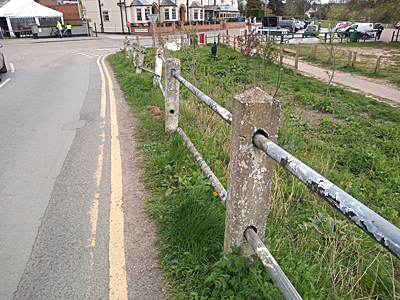 |
|
| Two
more potential new moths for Nottinghamshire from 2020
Earlier in 2021, Tom Shields sent his moth records from 2020. Normally, these would be filed away till the end of the year and the next round of distribution map updates. But with a little spare time, I went through Tom's spreadsheet and there are two micros on it, that appear to be new to Nottinghamshire. The first of these was Gelechia senticentella, which went on to be recorded at Tom's Colwick garden on a number of occasions with a series of records between July 13th and August 12th. G. senticentella first appeared in the UK in 1988 and has spread northwards since, benefitting from the regular planting of Cypress (Chaemocyparis and Cupressus) and Juniper (Juniperus) in gardens. Tom's second new species was Nemapogon koenigi, which was trapped at Centre Parcs on July 31st. Both species should certainly be looked for this coming Summer. |
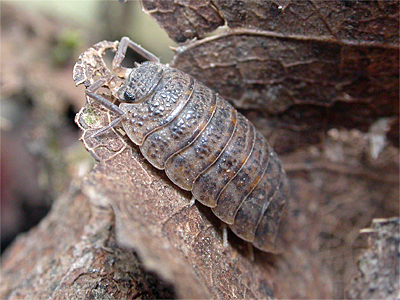 |
Trachelipus rathkii - another new Woodlouse for VC56
Possibly the last of the large UK woodlice we could have expected in Nottinghamshire, has been found at Stoke Bardolph. Trachelipus rathkii (Brandt, 1833) could easily be mistaken for the variable Porcellio scaber and experience with woodlice is probably key to recognising it as being something a bit different. Always found near to water Trachelipus rathkii occurs under stones, peices of wood and other long standing flood debris. Nottinghamshire's first, were found at Stoke Bardolph, initially under the loose bark of some felled trees in a now disused car park near Burton Joyce, but then more turned up under an old rabbit hutch door and under stones on the bank of the River Trent. The whole area had recently been under water, following the Trent bursting its banks earlier in the year. Its expected to be elsewhere locally along southern reaches of the Trent in Nottinghamshire, so check under logs or stones which are prone to flooding. |
|
|
What Harvestman next for Nottinghamshire? Following on from the exciting discovery of Nottinghamshire's first Platybunus pinetorum (C.L. Koch, 1839) at Gleadthorpe in 2020, and with a number of other Harvestmen (either large or extremely tiny) turning up at other sites across the UK, it rather begs the question as to what's possibly next for Nottinghamshire? The next most likely Nottinghamshire addition would be the confirmation of Dicranopalpus caudatus (Dresco, 1948). This has recently been seperated from the once easy to identify Dicranopalpus ramosus (Simon, 1909) after recent research by Hay Wijnhoven and Carlos E. Prieto, ended with the revalidation of Dicranopalpus caudatus to seperate species level once again. Visually identical to D. ramosus, microscopic examination of the male penis is required to determine species with certainty. But here's the three most likely species to turn up in Nottinghamshire, based purely on the fact that they are all in the UK already. |
|
|
Is there new hope for Clipstone Old Quarter's
Glow Worms? After years of neglect, leading to a quite remarkable deterioration of some wonderful grass heathland habitat, there appears to be hope on the horizon for the possible restoration of Clipstone Old Quarter. Clipstone Old Quarter forms part of the Birklands West and Ollerton Corner Site of Special Scientific Interest (SSSI) which is one of two SSSI's making up the Sherwood Forest National Nature Reserve (NNR). |
||
| ... | ||
| Regular visitors to
www.eakringbirds.com will be
aware of our association with Glow Worms, in particular with our
former study colony at Clipstone Old Quarter. It's an association
that is well known across the UK and one which is (or at least was)
enormously well respected among those with a similar interest in
Glow Worms. But ultimately it was an association which became tainted, as opinions divided, egos clashed and in particular, that those monitoring some Glow Worm
related groups on social media,
became so controlling and authoritarian that it made many feel that
they had no option other than to leave. We were among those who felt compelled to leave. But leaving the ever increasing aggressiveness of social media was never a problem, as we were forced through ill health to ease down and ultimately cease regular surveying of Glow Worms at Clipstone Old Quarter. It was an association which began back in 2008, following a chance encounter with a wandering Glow Worm larva and the rest as they say .... is history. That chance encounter led to well over 1,000 site surveys, never missing a night from before the first female emerged, till around a week after the last female was recorded glowing wherever it was on site. |
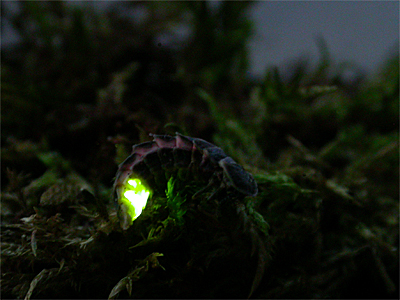 |
|
| .... | ||
| It was a mammoth effort, incredibly worthwhile and which eventually led to new information regarding the biology and habits of this wonderous and quite magical beetle. Surveying finally stopped in 2017, after ill health finally forced us to reduce our survey area to a more practical and managable level. It ultimately turned out that 2017 was a short season - not believed to be shorter as a direct consequence of surveying less of the site than normal, but more likely induced via several other factors once comparisons with previous years data had been made. This included a possible natural decrease in the population (especially of females) in some survey sections. |
| ... |
|
Fig 08 shows the maximum
recorded percentages of 'one night' females at Clipstone
Old Quarter between 2010 and 2017. The total number of
males (nM) recorded during each season is given in column
two, with column three showing the date range per 50
females involved and column four giving the peak
percentage of females mated on the first night. The high number of males was the subject of many conversations between Glow Worm enthusiasts on social media. But the percentage of 'one night' females eventually proved to be similar to three other seasons, despite us thinking to the contrary at the time. In the end, what had initially seemed to be very high numbers of males at the time, wasn't really that unusual based on our own records. |
|||||||||||||||||||||||||||||||||||||||||
| ... | ||||||||||||||||||||||||||||||||||||||||||
| But it was other factors such as habitat and larval loss resulting from damaging commercial forestry operations that probably had the greatest effect. These operations were neccessary on two accounts - one being that Pine is purely grown by Forestry England as a profitable crop at the end of the day and second, that the removal of Pines was required as part of Natural England's existing management plan to restore Sherwood Forest NNR's Pine plantations back to lowland heath. |
| .. |
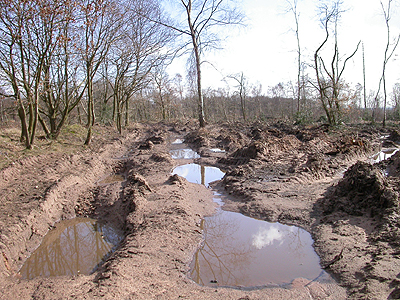 |
But the process of felling and extraction
takes a heavy toll on habitat, especially when operations are
carried out in wet weather.
The felling and removal of one particular Clipstone Old Quarter
plantation in 2014 proved disastrous and effectively left the area looking like the
Somme battlefield. It was no exaggeration, as the picture on the
left shows. Although the habitat lost along this area has since recovered to a
degree, Glow Worm numbers haven't. Over the years, damage has been considerable to some areas of Clipstone Old Quarter through one means or another and it takes several years before it becomes suitable again. Glow Worm numbers in the worst affected areas have yet to show any real signs of increasing again, even five years after. Increases in Glow Worm populations following large-scale losses are slow and if habitat remains unsuitable, or there is persistant disruption for a number of years, damage to Glow Worm populations in forested areas increases year on year. Eventually these populations weaken, become increasingly less viable and ever more isolated and eventually tend to die out. |
| ... | ||
| Its the site's larval populations that generally takes the brunt of forestry operations when the Autumn and Winter felling and extraction work is generally carried out. But Glow Worms are tenacious beetles and small numbers can withstand even the worst apocalyptic destruction for a time, although the damage to fragile populations is usually done by then and it takes many years for numbers to recover to anywhere remotely near previous levels. These small populations have proved difficult to find and our research has showed that these populations consist at best, of just a handful of females each year. It means that you can walk the forest for years and only locate these isolated populations after maybe four or five years. You just happen to strike lucky. | ||
|
Volunteer surveying on behalf of the Nottinghamshire Glow Worm
Survey (NGWS) has located females in previously unknown areas of the
Country Park and other forested areas adjacent to Clipstone Old
Quarter. But while these small populations might suggest the Glow
Worm is common, it has been found not to be the case. The map shows all the Glow Worm locations recorded in the general Sherwood Forest area of Nottinghamshire. The locations are based on existing records and those recieved by the Nottinghamshire Glow Worm Survey since 2012. The smaller dots refer to locations with very small populations or number of records, sometimes based on the sighting of just a single glowing female. The largest red dot is Clipstone Old Quarter, which is part of three Glow Worm population complexes in this part of Nottinghamshire, namely (from top to bottom) Clumber Park, Sherwood Forest NNR and Sherwood Pines. Glow Worms in the Harlow Wood area now seem solely restricted to Harlow Wood, but there are a handful of former Glow Worm sites located at nearby commercially forested sites. These have been well surveyed by NGWS surveyors but always produced negative results. The recovery of Glow Worm numbers in the worst affected areas of Clipstone Old Quarter, have yet to be recorded and the same applies to any of the other small, isolated Glow Worm populations also monitored in the Sherwood Forest NNR. But while forestry operations have contributed greatly to Glow Worm decline at Clipstone Old Quarter, its certainly not the only contributor. Sorry if you liked car rallying, but the ending of the Dukeries Car Rally stage through Sherwood Forest was largely down to us and several other parties, after putting the (then) Forestry Commission under pressure to stop hosting the rally. It was done for conservation purposes only and even now, still seems unbelievable that the event was ever allowed to go through a National Nature Reserve in June, especially considering that Natural England or the renamed Forestry England never insisted on any protection measures to the habitat from oil spills and fires as a result of crashes etc. Rather ironically, if you wanted to run a moth trap on Forestry England land, they would not issue you with a permit to trap without having a petrol spill kit! But we had good reason to get the rally stopped. The effects of the rally in June were great, regardless of whether it was bone dry or very wet. Either way, the vegetation on the forest track verges became covered in thick dust, sand and stones, or a chocolate-like mud, while other areas were trodden by the watching public. And then, following the rally each year, came the mechanical scraping and smoothing of the forest tracks, which saw the resulting stone spoil tipped on to the verges, disaster for many Glow Worms and other invertebrates. |
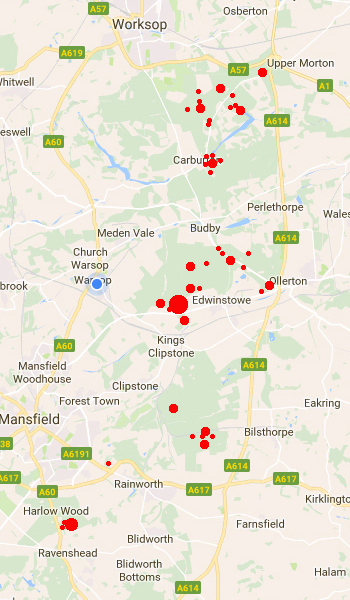 |
|
| ... | ||
| The Dukeries Rally was also proven to be responsible in the eradication of at least one Nightjar nest which in a way perhaps helped the cause. So at least we had other parties with the same view as ours, agreeing that a National Nature Reserve was not the place to hold an event of this kind, especially when considering it was detrimental to some of the species it was supposed to be giving protection to. It would have been fine for the event to have been held in Autumn or Winter and we'd have had no problem with that. |
| ... |
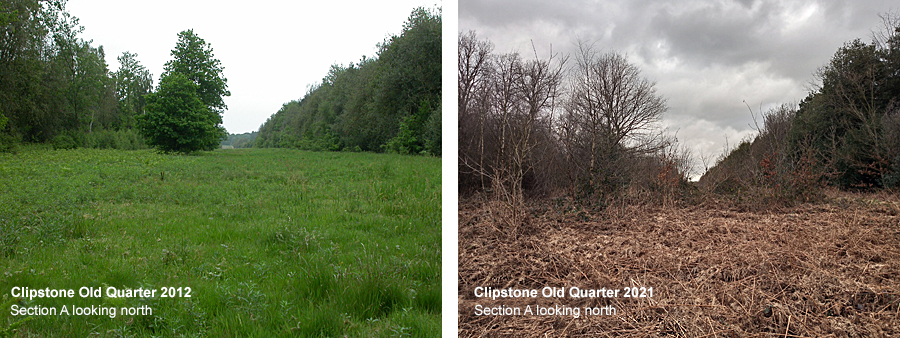 |
| ... |
| But one of the most worrying factors was the deteriorating conditions along the grass strip running alongside the Sustrans path. Increasing scrub encroachment along sections A, B and C, meant that it soon became impossible to survey those sections, as existing stands of Bracken and Bramble encroached further. But Birch and Oak scrub soon added to the increasing Bracken and Bramble problem and it was a problem that nobody addressed. Up until the Autumn and Winter of 2015/16, the grass strip was always cut once a year between September and March. |
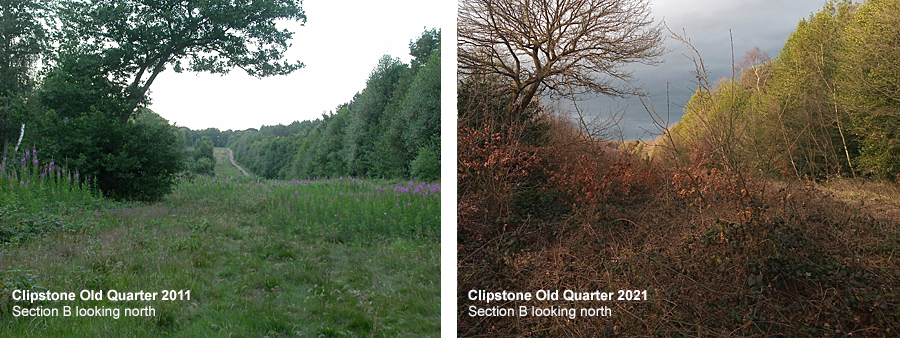 |
| This we had previously agreed as being suitable for Glow Worms, when we had a group walk and talk with the Forestry Commission's ecologist and other FC staff a number of years previously. The aim was to show those attending Glow Worms, to walk around Clipstone Old Quarter, talk about their ecology, habitat requirements and to discuss how the site could be better managed. They even helped us with the night's surveying and it all ended extremely positive. |
|
But after 2015,
the annual cutting of the grass strip running alongside the Sustrans
path stopped. Since 2008, it became known as sections A, B, C and D
of our survey route to Glow Worm enthusiasts across the UK and
Europe, who visited
www.eakringbirds.com for
regular updates and sightings. The well known and popular attraction of the website was how frequently it was updated. Having up to date results and survey counts on an almost daily basis (often updated immediately on arrival back home) ensured that people regularly kept visiting the website. It was also quite unique as being the only website to provide quality, reliable data and updated analysis on a daily basis. It made people keep coming back. Clipstone Old Quarter soon became nationally known for producing the first larva and first female Glow Worm in the UK on numerous occasions. Indeed, it is known that some never began visiting their Glow Worm sites, until the first had appeared here. This happened on a number of years between 2009 and 2020 and was something we put down to our habit of beginning surveys a couple of weeks before the we thought the first female would occur. |
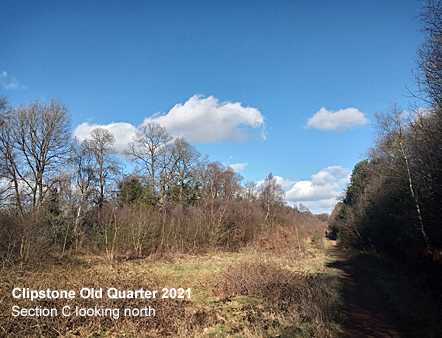 |
|
|
Cutting had always been done by tractor pulled gang mower, either in
early Spring or late Autumn and to a minimum height of four inches.
The last mowing of sections of A, B, C and D, took place sometime
between September 2015 and March 2016 and it has remained untouched
since. This has allowed the spread of extremely invasive plants such
as Bramble, Willowherb and Bracken to encroach across all grass
sections. Oak and Birch scrub soon added to the encroachment
problem, which increases as you near the A6075 Peafield Lane. The speed at which the grass/heath habitat has deteriorated has really been astonishing, so the accompanying 'then and now' photographs will give the reader some indication of both the mouting problem and short timescale. But how its been allowed to become such a problem is something of a mystery. |
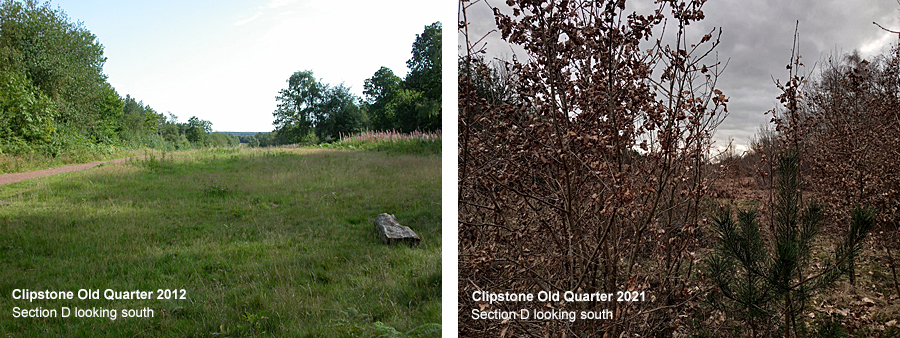 |
|
Back in our 2017 Glow Worm summary, it was mentioned that 'section D
was becoming less suitable for
Glow Worms and is now in need of some light management.
This year, it seemed increasingly evident that females
were becoming more confined to the centre of the grass
strip in Section D, as scrub and invasive weeds encroach
from both sides'. Well looking at the grass sections now, such a
comment shows just how right our opinion was at the time. Scrub Oak
and Birch growth, alongside Bramble and Bracken etc, have now become
such a problem that it is now totally impossible to walk the grass
strip anymore. The difference is unbelievably sad, in view of what
Clipstone Old Quarter once was. But I have no idea if it was planned to miss a few years cutting as part of some deliberate management decision, but I think not and so somehow the site has been left and the grass strip has deteriorated alarmingly. Vegetative encroachment has assisted the decrease in the number of females being found along the path edges in this section. We had noted this particular aspect of population shift and decline in previous years. So female larvae searching for a pupation site with an open aspect (ideal for glowing and attracting males from) now either have to wander further, or are forced to pupate in a less suitable (heavily vegetated) site than they did a few years ago. |
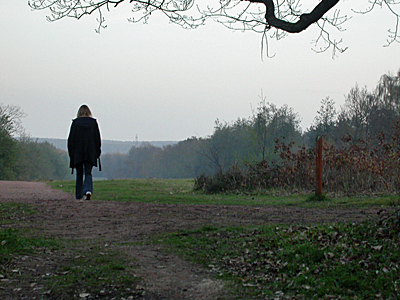 |
Whichever way it's looked at,
Clipstone Old Quarter has been neglected by those responsible for
managing the Sherwood Forest NNR. Personally, I think that all the
effort and available money has been concentrated towards the
Sherwood Forest Country Park and Budby South Forest. Both these
sites now come under the management of the RSPB, although Natural
England presumably still have final say in the day to day management
of both these areas and the rest of the NNR. Whether the lack of yearly cutting has evolved as the result of confusion between the landowners, Natural England or Forestry England, as to who's responsibilty the cutting actually is I have no idea. Despite Clipstone Old Quarter forming part of the Birklands West and Ollerton Corner SSSI, the only work undertaken has been the removal of the last of the Pines a few years ago, the removal of the compartment fencing and (in 2021) the wooden compartment gates, the yearly cutting of the forest track verges, Bracken control in the clear fell areas, haloing around some of the ancient Oaks, but seemingly nothing to help the site's Glow Worm population. |
|
|
Now we've always been more than aware that Glow Worms are afforded
no protection status through being especially rare or uncommon,
but our own years of continuous surveys, in addition to those sent
in to the Nottinghamshire Glow Worm Survey, all show that the
Nottinghamshire population has declined and still continues to do
so. No matter which particular 'authority' you listen to, those with an interest and intimate knowledge of the county's Glow Worms, agree that there is a very valid concern for the long term survival of the Glow Worm in Nottinghamshire. Fellow Glow Worm enthusiast and local expert Martin Dale, Dilys and myself, tried for years to get some official recognition that there is a decline in UK Glow Worm populations, as well as in Nottinghamshire. But it seems that as long as the odd Glow Worm keeps turning up in gardens across southern UK counties, then there is blanket refusal to accept the declines noted from a number of counties, even those declines recorded by a number of other experts. It is easy for those who sit at home and dismiss our claims as fanciful, which makes it all incredibly frustrating. It seems that there is reluctance to accept, or indeed even publish any news or findings with a negative slant. But at last there seems to be some hope and following a chance meeting with representatives from the Sherwood Forest Trust and Thoresby Estate recently, it was determined that something is actually being done and probably beginning late in 2021. There obviously needs to be a number of meetings and consultations to determine a plan of action to take and based on the opinions of the various interested/involved parties. I have been asked to be involved and I have initially accepted the offer. But make no mistake, the problem of returning Clipstone Old Qaurter to something like its best is a large one and one which will require much effort from all parties to be make it successful. It will be drastic work, as the grass strip has dreadfully deteriorated, the Sustrans path needs reinstating to previous its width and needs levelling as there is increasing erosion from rainfall and mechanical erosion from footfall and cycle use. The work will affect Glow Worms, but it has to be done now and thankfully, it seems that the wheels are in motion ... at last. Let's hope the Glow Worm is in for a better future here. |
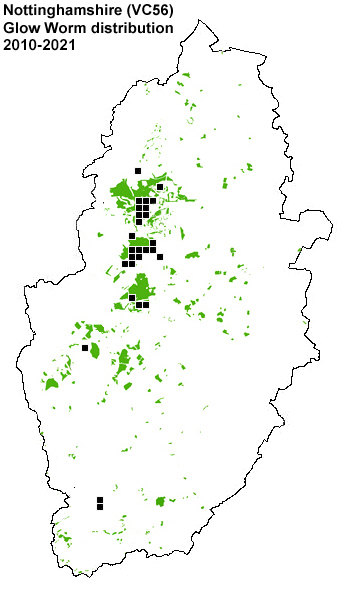 |
|
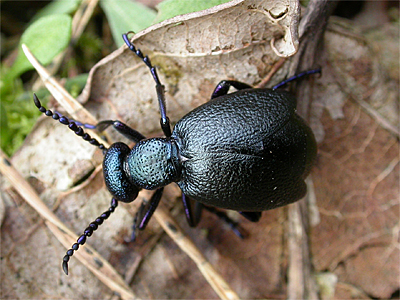 |
Early 2021 Oil Beetles survey results
After two early surveys, the first Oil Beetle of the year (a male) was found freshly emerged and heading for cover on a fairly breezy, but mild February 18th. In terms of early dates, this looks to be the earliest at Budby and follows a spell of cold weather that ended a few days prior to my visit. The next report was of two females present on February 27th, when I was expecting better numbers, given the recent mild weather. I must admit to being concerned that this population is weakening. A site visit on March 7th produced a total of seven adults, which included five males and two females. Five of these were found on the spoil heaps created from recently scraped areas of the heath. Seven is still a low count, but the weather had been dry and cool with occasional frosts since my previous visit. |
|
|
New to Nottinghamshire - Bankesia conspurcatella
(Zeller, 1859) Taleporiinae:Psychidae A quite remarkable discovery, which should serve as a reminder to all, that important county records can occur anywhere. Found by Phil Cadman on his Worksop kitchen wall on February 27th, 2021, Phil potted the moth and identified it as bpossibly being Dahlica inconspicuella, a moth which is visually almost identical. |
||
| ... | ||
|
The identification seemed sound when Phil emailed the details and was
the most likely species based on photographs. However, in view of the suburban Worksop location and Dahlica inconspicuella's restricted range in the county, I suspected that it may be Bankesia conspurcatella, based on the knowledge that Bankesia conspurcatella had turned up in urban areas before. I talked with Phil and suggested he brought the moth over to me, so that I could photograph it, before considering getting the identification checked to be certain. On photographing the specimen and then later checking images on the internet, I considered Bankesia conspurcatella to be the more likely suspect. But as my suspicion was only based on seeing a number of Dahlica inconspicuella males, which all looked to have more plain, leaden grey markings than this specimen, we needed to get it checked. And so thanks to the very kind assistance of Martin Gray, the following morning, the moth was indeed confirmed as being Bankesia conspurcatella within a few hours. |
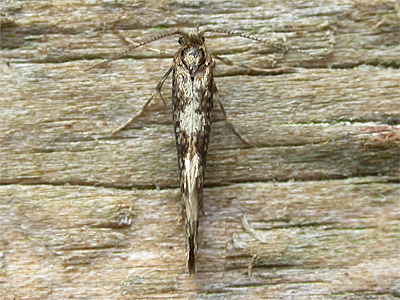 |
|
| Large
numbers of Dahlica triquetrella at Market Warsop
On February 19th 2021, I visited Market Warsop Cemetery, where numbers of Dahlica triquetrella (Hübner, 1813) larval cases were found on a number of gravestones situated close to the cemetery entrance in late 2020. It was the first time D. triquetrella had been recorded there and the discovery came soon after finding it present on gravestones at Retford Cemetery. Finding it at Market Warsop was a surprise at the time, considering how many times the site had been visited to look for the similar cases of Dahlica lichenella (Linnaeus, 1761). Sadly, that species seems to be in decline there over the past few years, but does still remain. It would certainly be worth checking old gravestones in cemeteries throughout in Nottinghamshire. Rock Cemetery in central Nottingham would be worth trying. |
| New
leaf miners for Foxcovert Plantation and Ploughman Wood
Following a tip on Facebook, where I asked people to look out for two common Bramble leaf miners and it's extremely pleasing to say that at least one person took up the challenge and immediately met with success. And through the easy exchange of photographs via WhatsApp, I was able to identify some blotch mines as being created last Autumn by the larva of Coleophora violacea (Ström, 1783). This was quickly followed by photographs showing the silvery/white gallery mine of Stigmella aurella (Fabricius, 1775). Despite Stigmella aurella being abundant and likely found in every square kilometer of the county, both finds by Julie Lockett represent new species for the NWT's Foxcovert Plantation reserve. Julie's early success was soon followed up by sending over some more photographs, which I identified as both Coleophora violacea and Stigmella aurella again, but also Coptotriche marginea (Haworth, 1828). All three species appear to be new to Ploughman Wood at Lambley and once again shows how little we know of what species are at many sites and which (via modern technology) can be identified almost instantly. It also emphasises how easy it is for anyone to make a useful contribution to our knowledge of species diversity. |
|
The Staphylinid Bledius limicola
on Thoresby Pit Top
A visit to Thoresby Pit Top in January proved fruitful in proving that the attractive Staphylinid Bledius limicola (Tottenham, 1940) appears to have colonised the site. Bledius limicola has a largely coastal distribution around the UK, with only two unconfirmed records from South Yorkshire and Cambridgeshire listed on the NBN Atlas. Derek Lott listed a single Nottinghamshire record, quoted as (Wright, Nottingham 1990) in the Handbooks for the Identification of British Insects Vol. 12 Part 5, but this record has failed to make it onto the NBN Atlas. There appear to be no other documented records from Nottinghamshire, until two in 2020, which included one attracted to MV light trap run in Market Warsop on a warm, humid night of high insect activity on 23/06/20. Due to the rare nature of Bledius limicola in Nottinghamshire, the specimen (a female) was sent to the county recorder who confirmed the original identification. |
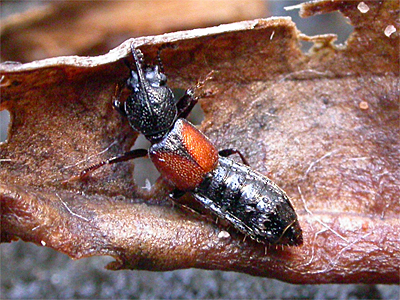 |
|
| Another female was then found later the same year, recorded in a small tunnel dug underneath a small stone on Thoresby Pit Top on 08/08/20. On another visit to Thoresby Pit Top on 21/01/21, a total of 12 Bledius limicola were found in a complex of tunnels dug underneath an old plastic traffic sign discarded on the pit top. This obviously proved that successful breeding had taken place and among those found, were a number of horned males. | ||
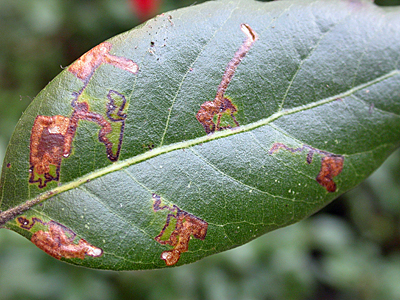 |
Ectoedemia heringella mines found at Southwell The distinctive leaf mines of one of Nottinghamshire's more recent colonisers, Ectoedemia heringella (Mariani, 1839) are best looked for during the Winter months. Although found new to the county in 2020, it is still uncertain whether Ectoedemia heringella had been recorded in Nottinghamshire previously. I cannot trace any records dated prior to the finding of several leaf mines on Holm Oak at Colwick Country Park in June 2020 and then at Nottingham University's Jubilee Campus in July 2020. It is a moth which is currently extending its range nationally, after being recorded for the first time in the UK at London in 2002. The host trees are a number of evergreen Oaks such as Quercus ilex, of which mature specimens are occasionally found in Parks and Gardens. Quercus ilex seems to have become increasingly used in recent planting schemes, so will allow this moth to continue to spread north. |
|
| Young trees planted at Nottingham University's Jubilee Campus are already heavily infested with leaf mines and by the end of last year, small numbers of Ectoedemia heringella mines were found on trees at Bulwell Hall and Woodthorpe Park. In late January 2021, I found small numbers of mines on a tree in the grounds of Southwell Minster. Like trees present at Woodthorpe Park and Arnot Hill Park, this tree had been checked for signs of this moth for a number of years. Several trees at Arnot Hill Park still need to be checked, as does another growing at the Nottingham Arboretum, which must have mines on them by now. Other trees to check can be found at Newstead Abbey and outside North Notts College on Carlton Road in Worksop. A Holm Oak at Carr Bank Park in Mansfield, was checked recently, but there was no evidence that Ectoedemia heringella has reached this far north in the county. | ||
| Insects |
| Homepage |